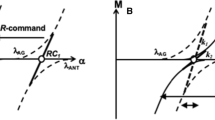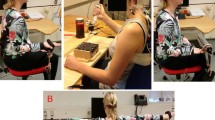Summary
During the performance of unidirectional, single-joint movements it is known that muscle activation is not confined to the agonist, but is generally seen in the antagonist as well, appearing as a burst of antagonist activity if the movement is quite rapid. We have studied the integral over time of antagonist electromyographic activity (Eant) during forearm movements encompassing a wide range of movement speeds, amplitudes and inertial loads, with two intents: first, to provide an empirical description of the dependence of Eant on kinematic and loading parameters which would be valid over a several hundred-fold range of Eant; and second, to test the hypothesis that Eant is related to the torque necessary for braking the movement. With respect to the first aim, we found that for all subjects Eant was correlated with a simple algebraic expression dependent upon peak velocity, movement amplitude and total moment of inertia, when each of these movement parameters was varied either singly or in combination. Although a more complex algebraic expression, in which exponents for each parameter were optimized for a given subject, provided marginally better correlations with Eant, we prefer the simpler expression on the grounds that it provides similar correlations without requiring a different form for each subject. With respect to the second aim of the study, the braking hypothesis was supported by the fact that the simple expression could be interpreted as representing the average net torque required for braking. However, in experiments in which an external torque was provided to assist in braking, antagonist muscle activity was not reduced as much as would be expected if provision of braking torque was the sole function of antagonist activity. We conclude that: (1) antagonist activity varies with kinematic parameters and inertial load in accordance with the requirements for braking the limb, but (2) the activity may in fact provide a multiple of the torque that is required for braking alone, with excess activity presumably offset by concurrent agonist activity. Possible roles of such cocontraction are discussed.
Similar content being viewed by others
References
Benecke R, Meinck H-M, Conrad B (1985) Rapid goal-directed elbow flexion movements: limitations of the speed control system due to neural constraints. Exp Brain Res 59: 470–477
Berardelli A, Rothwell JC, Day BL, Kachi T, Marsden CD (1984) Duration of the first agonist EMG burst in ballistic arm movements. Brain Res 304: 183–187
Brown SHC, Cooke JD (1981) Amplitude- and instruction-dependent modulation of movement-related electromyogram activity in humans. J Physiol (Lond) 316: 97–107
Brown SH, Cooke JD (1984) Initial agonist burst duration depends on movement amplitude. Exp Brain Res 55: 523–527
Chandler RF, Clauser CE, McConville JT, Reynolds HM, Young JM (1975) Investigation of inertia properties of the human body. AMRL Technical Report 74-137, Wright Patterson AFB
Corcos DM, Gottlieb GL, Agarwal GC, Liubinskas TJ (1986) Effect of movement distance, accuracy and inertial load on agonist and antagonist EMG patterns. Soc Neurosci Abstr 12: 470
Darling WG, Cooke JD (1983) The influence of practice on movement dynamics and muscle activity. Soc Neurosci Abstr 9: 1032
Flamen D, Hore J, Vilis T (1984) Braking of fast and accurate elbow flexions in the monkey. J Physiol (Lond) 349: 195–203
Freund HJ, Büdingen HJ (1978) The relationship between speed and amplitude of the fastest voluntary contractions of human arm muscles. Exp Brain Res 31: 1–12
Ghez C, Martin JH (1982) The control of rapid limb movement in the cat. III. Agonist-antagonist coupling. Exp Brain Res 45: 115–125
Ghez C, Vicario D, Martin JH, Yumiya H (1983) Sensory motor processing of target movements in motor cortex. In: Desmedt JE (ed) Motor control mechanisms in health and disease. Advances in neurology, Vol 39. Raven Press, New York, pp 65–67
Gielen CCAM, van den Oosten K, Pul ter Gunne F (1985) Relation between EMG activation patterns and kinematic properties of aimed arm movements. J Motor Behav 17: 421–442
Hallett M, Marsden CD (1979) Ballistic flexion movements of the human thumb. J Physiol (Lond) 294: 33–50
Hannaford B, Stark L (1985) Roles of the elements of the triphasic control signal. Exp Neurol 90: 619–634
Hasan Z (1986) Optimized movement trajectories and joint stiffness in unperturbed, inertially loaded movements. Biol Cybern 53: 373–382
Hasan Z, Enoka RM (1985) Isometric torque-angle relationship and movement-related activity of human elbow flexors: implications for the eqilibrium-point hypothesis. Exp Brain Res 59: 441–450
Hasan Z, Enoka RM, Stuart DG (1985) The interface between biomechanics and neurophysiology in the study of movement: some recent approaches. Excerc Sport Sci Rev 13: 169–234
Hinrichs RN (1985) Regression equations to predict segmental moments of inertia from anthropometric measurements: an extension of the data of Chandler et al. (1975). J Biomech 18: 621–624
Hogan N (1984) Adaptive control of mechanical impedance by coactivation of antagonist muscles. IEEE Trans Autom Contr AC-29: 681–690
Karst GM, Hasan Z (1986) Antagonist muscle activity during human elbow movements under different kinematic and loading conditions. Soc Neurosci Abstr 12: 470
Lestienne F (1979) Effects of inertial load and velocity on the braking process of voluntary limb movements. Exp Brain Res 35: 407–418
Larue J, Roy M-A, Bard C, Fleury M, Lagasse P (1986) Relationship between EMG triphasic pattern and accuracy of movement. Soc Neurosci Abstr 12: 470
Marsden CD, Obeso JA, Rothwell JC (1983) The function of the antagonist muscle during fast limb movements in man. J Physiol (Lond) 335: 1–13
MacConaill MA, Basmajian JV (1977) Muscles and movements: a basis for human kinesiology. Robert E Krieger Publishing Company, Huntington, pp 134–135
Meinck H-M, Benecke R, Meyer W, Hohne J, Conrad B (1984) Human ballistic finger flexion: uncoupling of the three-burst pattern. Exp Brain Res 55: 127–133
Person RS (1958) An electromyographic investigation on coordination of the activity of antagonist muscles in man during the development of a motor habit. Pavlov J High Nerv Act 8: 13–23
Sanes JN, Jennings VA (1984) Centrally programmed patterns of muscle activity in voluntary motor behavior in humans. Exp Brain Res 54: 23–32
Stern JT (1971) Investigations concerning the theory of “spurt” and “shunt” muscles. J Biomech 4: 437–453
Waters P, Strick PL (1981) Influence of “strategy” on muscle activity during ballistic movements. Brain Res 207: 189–194
Wierzbicka MM, Wiegner AW, Shahani BT (1986) Role of agonist and antagonist muscles in fast arm movements in man. Exp Brain Res 63: 331–340
Zatsiorsky V, Seluyanov V (1983) The mass and inertia characteristics of the main segments of the human body. In: Matsui H, Kobayashi K (eds) Biomechanics VIIIB. University Park Press, Champaign, pp 1152–1159
Author information
Authors and Affiliations
Rights and permissions
About this article
Cite this article
Karst, G.M., Hasan, Z. Antagonist muscle activity during human forearm movements under varying kinematic and loading conditions. Exp Brain Res 67, 391–401 (1987). https://doi.org/10.1007/BF00248559
Received:
Accepted:
Issue Date:
DOI: https://doi.org/10.1007/BF00248559




